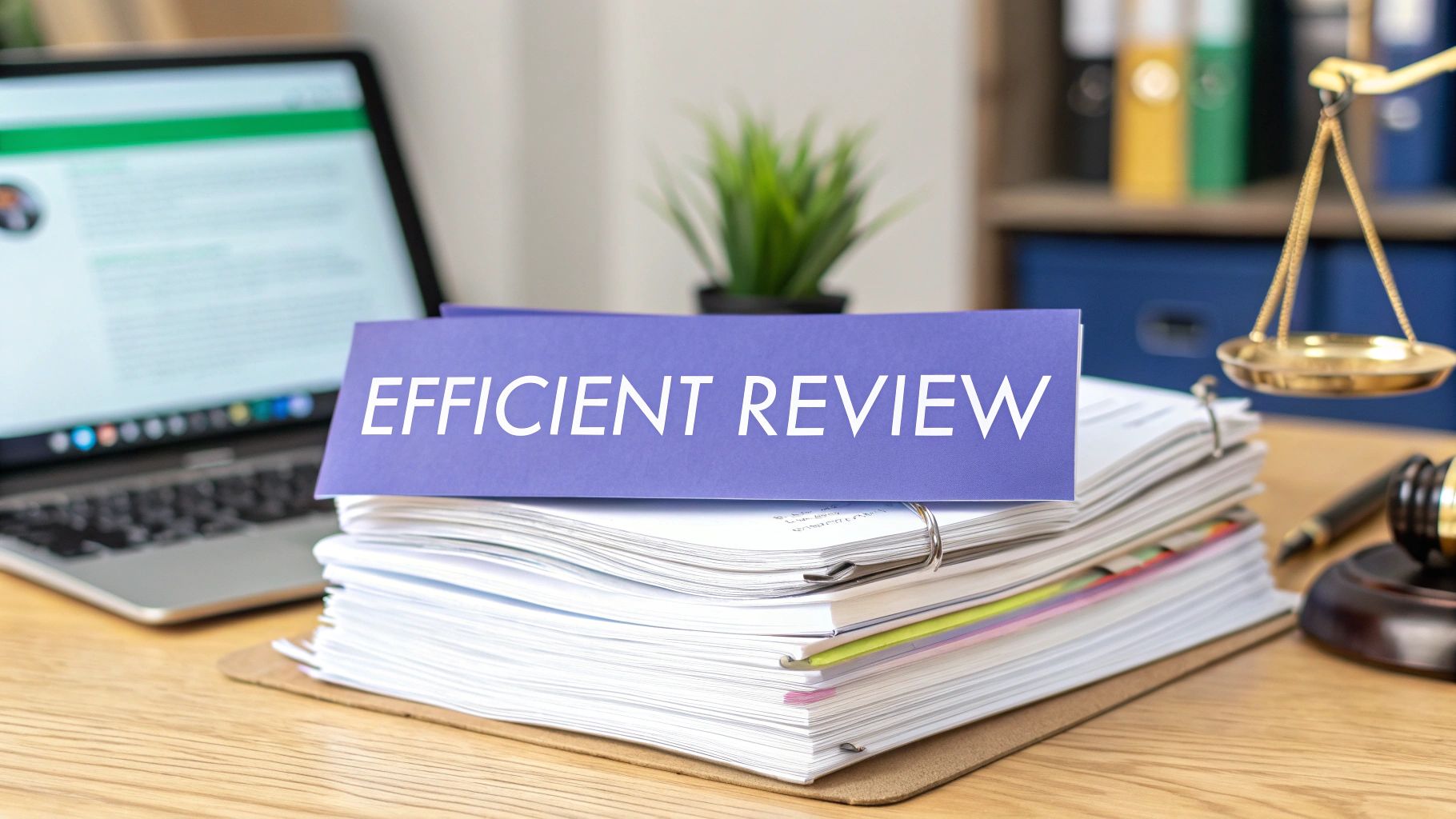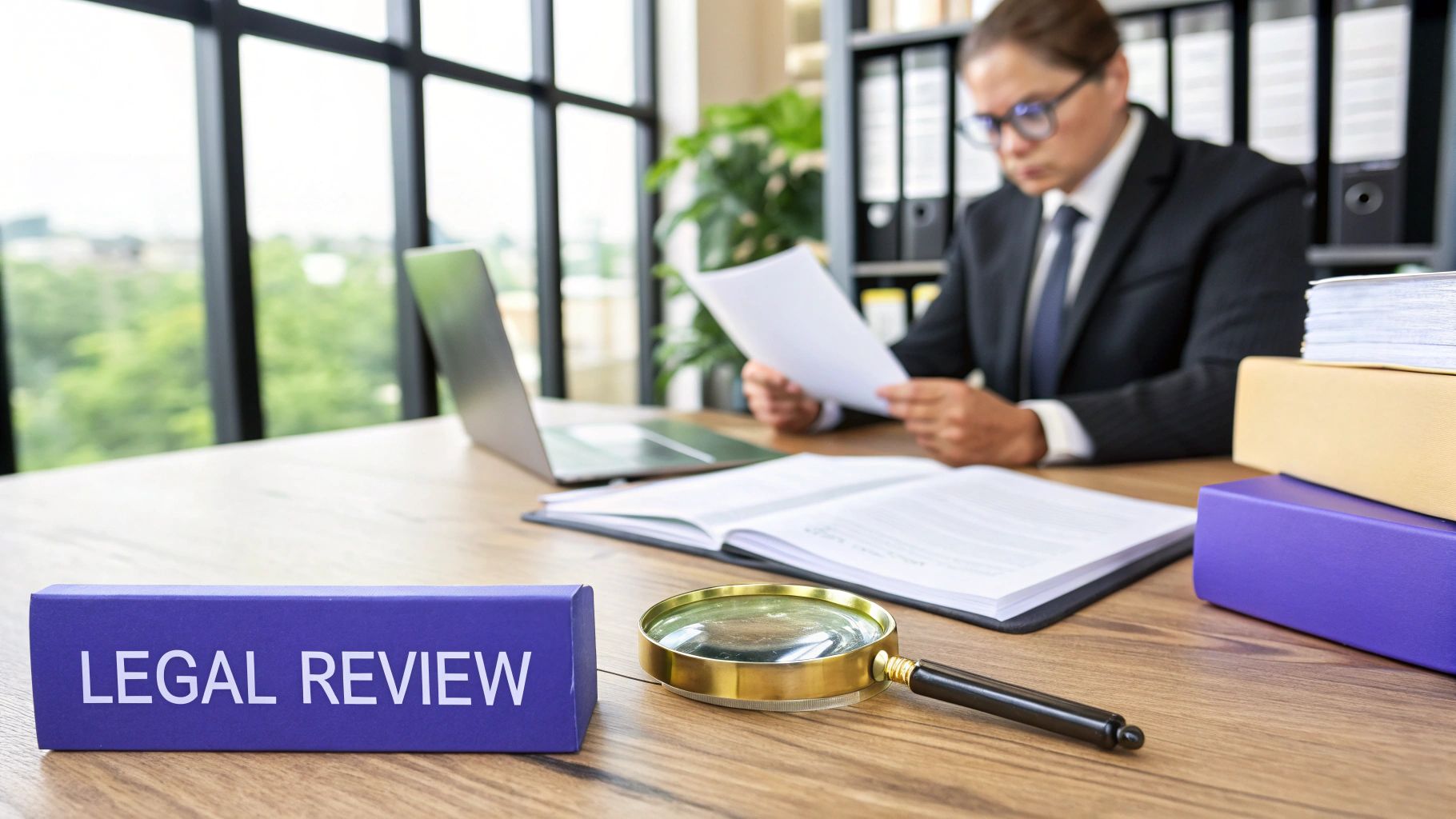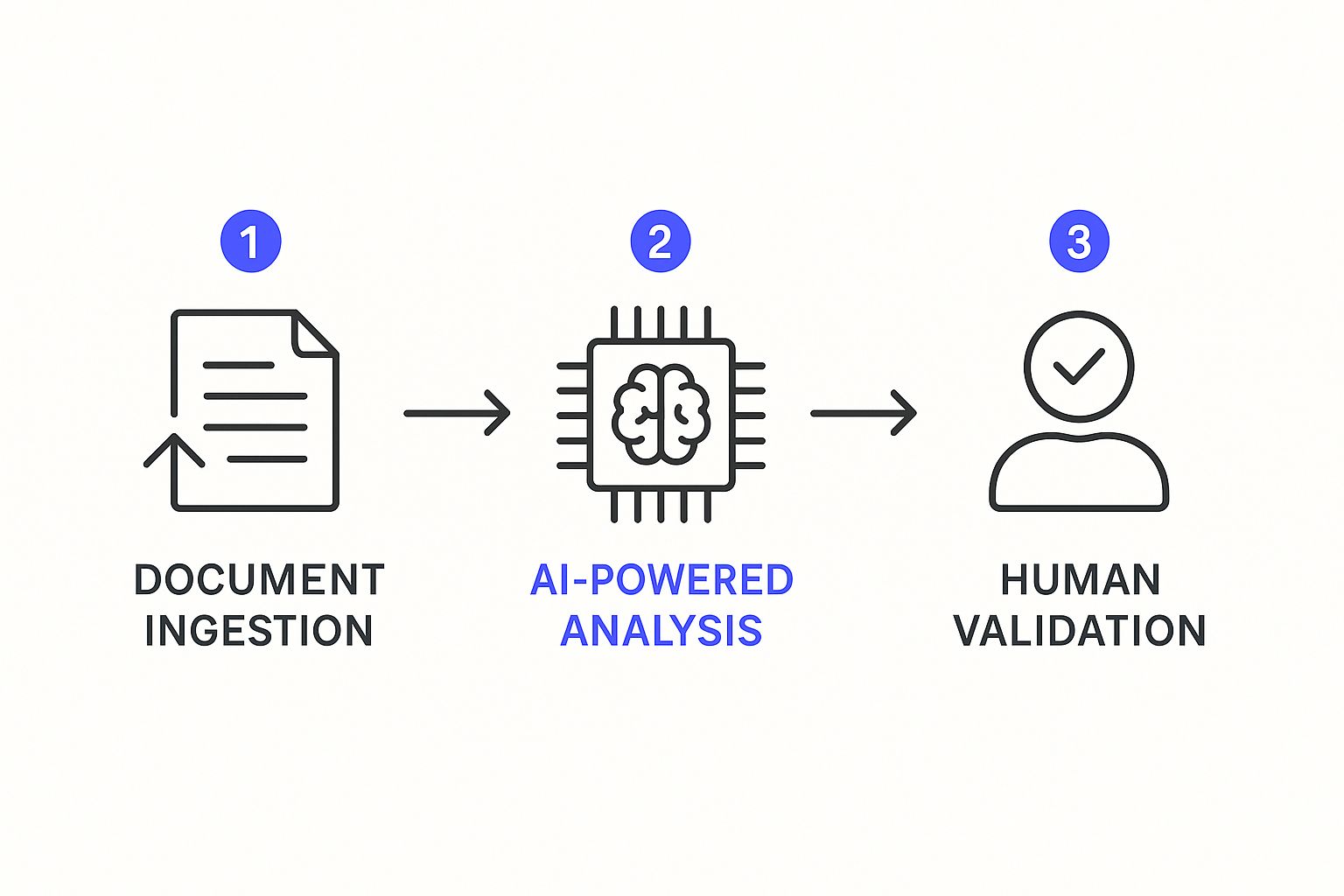
The Digital Transformation of Legal Document Review

The practice of legal document review has changed dramatically. Traditional manual review methods are no longer sufficient for the amount of data involved in today's legal cases. This requires legal teams to rethink their document review processes for better efficiency and accuracy.
The Data Deluge and Its Implications
The sheer quantity of data in modern litigation presents a significant hurdle. Legal professionals now deal with much more than just printed documents and emails. They must manage a wide range of electronically stored information (ESI), including social media content, instant messages, multimedia files, and data from collaborative workspaces. This digital explosion dramatically increases the scope and complexity of legal document review. To better understand these changes, it's helpful to consider the wider impact of digital transformation across the legal industry.
One of the biggest challenges is the volume and complexity of ESI. The need to include ESI in discovery has grown over the past two decades, creating a constantly shifting data landscape. This includes diverse communication formats like chats, emojis, voice notes, disappearing messages, and embedded images from platforms like Slack, Microsoft Teams, and WhatsApp. These communication methods are now commonplace in corporate settings. For more on these challenges, see Document Review Challenges Law Firms Face.
Client Expectations and Regulatory Demands
This data explosion comes at a time of increasing client expectations for cost-effectiveness and speed. Clients want faster turnaround times and greater transparency in legal proceedings. This pressure, combined with evolving regulations around data privacy and security, creates a complex challenge for legal teams.
The need to comply with these evolving regulations adds another layer of complexity. Regulations like GDPR and CCPA place strict rules on data handling. Legal teams must adapt their processes to ensure they comply with these rules, implementing secure and auditable document review systems to safeguard sensitive information.
Embracing Technology for Enhanced Efficiency
Progressive legal teams are tackling these challenges by using advanced technology. Tools like Legal Document Simplifier help legal professionals extract key insights from large datasets quickly and accurately. This isn’t just about automation; it's about a more strategic approach to document review. It allows lawyers to focus on high-value work and deliver better results for clients. This technology helps legal teams manage the complex interplay of growing data volumes, client demands, and regulatory requirements.
Critical Challenges Reshaping Modern Review Practices

The sheer volume of data isn't the only hurdle for legal teams. They face complex issues barely imaginable a decade ago. This demands a new level of skill and technological adaptation in legal document review.
Collaboration Platforms and Context
Modern communication creates its own set of challenges. Platforms like Slack and Microsoft Teams generate intricate data webs. Context is key, scattered across messages, edits, and files.
Understanding a single message might require piecing together information from various sources within the platform. This adds layers of complexity to legal document review.
Data Preservation and Metadata
Data preservation and metadata present significant obstacles. Preservation failures can severely damage a case. Metadata inconsistencies can create confusion and obscure vital information.
Imagine a key email without a timestamp or sender. Its evidentiary value diminishes significantly. This underscores the need for careful data management in modern legal document review.
To further illustrate these challenges, let's examine the following table:
Modern Legal Document Review Challenges
This table outlines the major obstacles legal teams face during document review and proven strategies to overcome them.
| Challenge | Description | Potential Impact | Mitigation Strategies |
|---|---|---|---|
| Collaboration Platform Complexity | Difficulty in piecing together context from various communication sources like Slack and Microsoft Teams. | Incomplete understanding of evidence, missed connections, and weakened legal arguments. | Implement robust data archiving and eDiscovery tools that capture the full context of conversations, including edits, reactions, and linked files. |
| Data Preservation Failures | Loss or corruption of critical data due to inadequate storage or backup procedures. | Irretrievable loss of evidence, weakened case, and potential sanctions. | Establish clear data retention policies, use secure storage solutions, and implement regular backups with verification. |
| Metadata Inconsistencies | Missing or conflicting metadata across different data sources. | Difficulty in authenticating documents, establishing timelines, and tracing data provenance. | Standardize metadata tagging processes, implement data validation checks, and use tools that automatically capture and preserve metadata. |
| Scaling Review Capabilities | Difficulty in maintaining quality and consistency while reviewing large volumes of data. | Increased errors, missed deadlines, and higher review costs. | Leverage technology-assisted review (TAR) solutions, implement quality control checks, and develop standardized review workflows. |
| Skills Gap | Lack of technical expertise among legal professionals to effectively handle modern data and review tools. | Inefficient review processes, inability to leverage advanced technologies, and compromised outcomes. | Invest in training programs that focus on data analytics, eDiscovery tools, and technology-assisted review techniques. |
This table highlights the complexities and potential consequences of these issues, along with practical strategies to address them. By adopting these mitigation strategies, legal teams can improve the efficiency and effectiveness of their document review processes.
Scaling Review and Maintaining Quality
Many firms struggle to scale their review processes while upholding quality. As data grows, ensuring consistent and accurate review becomes more difficult. Traditional methods often fall short.
This requires new strategies, including technology-assisted review solutions, like those from Legal Document Simplifier, which promote accuracy and consistency at scale.
Bridging the Skills Gap
A growing gap exists between traditional legal training and the technical expertise modern review requires. Finding and training personnel who can handle complex data and technology is crucial. Legal professionals now need proficiency in both legal principles and data analysis tools.
Turning Challenges into Opportunities
These challenges also offer opportunities. Firms that proactively address these issues gain a strategic edge. By adopting advanced technology, developing strong workflows, and investing in training, legal teams can transform obstacles into opportunities for greater efficiency and better results.
AI's Game-Changing Impact on Legal Document Review

The legal field is constantly evolving, and the rise of Artificial Intelligence (AI) is significantly impacting legal document review. AI offers more than just minor improvements; it’s changing what’s possible. It's reshaping how legal teams approach this essential process.
Generative AI and Machine Learning: A New Era
Conversations with leading law firms reveal that generative AI and machine learning are now practical tools. They offer capabilities previously considered futuristic. For example, predictive coding is evolving beyond basic categorization.
It can now identify conceptual links between documents, detect emotional cues, and highlight potential privilege issues with greater accuracy. This empowers lawyers to analyze data in new ways, gaining deeper insights and making more informed decisions. You might find this interesting: How to master AI for legal documents.
AI-Augmented Workflows: Blending Human Expertise and Machine Precision
Progressive firms are adopting AI-augmented workflows, blending the precision of machines with the expertise of legal professionals. This combination improves efficiency without sacrificing quality. The integration of AI is changing how legal document review is conducted. Learn how to improve efficiency and accuracy with AI for legal documents.
The year 2024 marked a turning point. The adoption of generative AI (GenAI) significantly altered document review processes. Top firms, many within the AmLaw 200, found that GenAI outperformed human reviewers in speed and accuracy for first-level review. This prompted a shift from traditional outsourcing to in-house, automated platforms powered by GenAI. Find out more about GenAI and outsourced document review.
Addressing AI's Limitations: Navigating Explainability, Bias, and Ethics
Integrating AI presents challenges. Understanding how an AI reaches a conclusion (explainability) remains a hurdle. This lack of transparency can be problematic in legal contexts requiring justification for every decision.
Potential algorithmic bias and ethical implications also require careful attention. Responsible legal teams are actively working to address these limitations. This ensures fair and unbiased outcomes by continuously evaluating AI-driven tools and processes.
Real-World Implementation: Lessons from Successful Firms
Practical application and responsible use are crucial. The current landscape of AI in law emphasizes thorough evaluation of AI tools and careful consideration of ethical implications.
Learning from firms already using AI-enhanced review is invaluable. These firms are leading the way, offering guidance for others looking to implement these technologies in their document review workflows.
Crafting a Bulletproof Legal Document Review Workflow
Moving beyond the theoretical benefits of AI, let's explore a practical workflow for legal document review that combines human expertise with technological advancements. This involves a detailed process, from the initial data collection and assessment to processing, analysis, review, and finally, production.
Establishing a Solid Foundation
A well-defined strategy is the cornerstone of any successful legal document review. This includes establishing clear review guidelines, creating a thorough coding manual, and implementing a robust quality control system. These components ensure accuracy and consistency throughout the process. Maintaining open communication within the team is also critical, particularly for complex cases. A solid foundation is as important for legal document review as it is for constructing a building.
Streamlining the Review Process
The infographic below illustrates a simplified, three-stage document review process enhanced by AI:

This streamlined workflow starts with document ingestion, followed by AI-powered analysis, and concludes with human validation. By using AI for the initial analysis, legal teams can drastically reduce the time spent on manual review. This allows human reviewers to concentrate on the more nuanced and complex aspects of the documents. For a deeper dive into contract review, check out our guide on How to master contract reviews.
To further illustrate the transformation AI brings to document review, let's examine a comparison table:
Document Review Workflow Transformation This table compares traditional document review approaches with modern AI-enhanced workflows across key performance metrics.
| Workflow Element | Traditional Approach | AI-Enhanced Approach | Performance Difference |
|---|---|---|---|
| Initial Document Review | Manual review of all documents | AI-powered analysis, followed by targeted human review | Significant time savings, reduced manual effort |
| Time to Completion | Weeks or months, depending on volume | Days or weeks, even with large volumes | Faster turnaround times |
| Cost | High due to extensive manual labor | Lower due to automation and reduced manual review | Significant cost reduction |
| Accuracy | Prone to human error, especially with fatigue | Higher accuracy due to consistent AI analysis and targeted human review | Improved accuracy and consistency |
| Focus of Human Reviewers | Tedious, repetitive review of all documents | Strategic review of complex or flagged documents | Enhanced efficiency and job satisfaction |
This table clearly demonstrates how AI-driven workflows improve speed, efficiency, and accuracy in document review. The shift allows legal professionals to focus their expertise where it truly matters.
Building an Effective Team
Another key component of successful document review is strategic team composition. Utilizing diverse skill sets and experience levels can greatly enhance efficiency. This could involve assigning junior team members to initial document coding, while senior attorneys focus on high-level analysis and strategy. This tiered approach optimizes resource allocation and minimizes costs.
Adapting to Different Case Needs
This flexible workflow can be adapted to various legal matters. Whether dealing with a routine investigation or high-stakes litigation, the core principles remain the same. For smaller cases, the review process might involve a smaller team and fewer review stages. However, for critical "bet-the-company" litigation, a more intensive, multi-tiered review with stringent quality control is essential. The key is scalability, adapting the workflow to align with the case complexity, data volume, and specific client needs.
Choosing Technology That Delivers Real Results
Finding the right tools for legal document review can be a challenge. With countless vendors promoting their products, it's easy to get lost in the marketing. This section provides a practical guide to evaluating technology based on proven performance, not just promises.
Essential Capabilities for Efficient Legal Document Review
Effective legal document review relies on specific functions to enhance efficiency and accuracy. Here's what you should look for:
Advanced Processing Engines: It's vital that your chosen technology can handle various file types, not just standard text documents. This includes images, audio, video, and other electronic data.
Intuitive Search: You need robust search capabilities to quickly find specific information within large volumes of data. Look for granular filtering, advanced keyword search, and conceptual search options.
Customizable Workflows: The technology should adapt to your existing processes, not force you to change them. Choose solutions that allow for workflow customization to fit the specific needs of each case.
Collaboration Tools: Legal teams thrive on collaboration. Features like real-time document sharing, commenting, and annotation can greatly improve teamwork and communication.
Comprehensive Reporting: Detailed reports and metrics offer valuable insights into the review process. This data-driven approach allows for informed decisions and continuous improvement.
These core features empower legal teams to effectively organize, analyze, and understand the evidence within their document collections.
Matching Technology to Your Needs
The best technology solution will depend on factors such as firm size, practice area, and the specifics of each case. A small firm focusing on contract review has different requirements compared to a large firm handling extensive litigation. Finding the right balance between powerful features and ease of use is crucial.
For example, a smaller firm may prioritize a user-friendly interface and affordability, while a larger firm might require more sophisticated analytics and automation.
Furthermore, the evolving nature of data in legal cases requires technology that can adapt to changing needs. This adaptability ensures long-term value and relevance in the legal tech field.
Focusing on practical solutions addresses the increasing complexities and costs associated with legal document review. Legal professionals face the constant challenge of managing vast amounts of data across various platforms. This has led to increased adoption of AI tools designed to meet client expectations for efficiency and accurate review outcomes. Learn more about these trends here.
Strategic Vendor Evaluation and Implementation
Choosing the right vendor demands a strategic approach. Pilot projects offer invaluable hands-on experience before committing to a particular platform. Clearly defined success metrics and ROI calculations, considering both direct and indirect benefits, are crucial for informed decision-making.
Successful implementation minimizes disruption to your workflow. Seamless data migration, comprehensive user training, and integration with existing systems, such as Legal Document Simplifier, ensure a smooth transition and encourage team adoption. This integrated approach allows legal teams to fully leverage technology throughout the document review process.
Building Iron-Clad Quality Control in Document Review
Maintaining high accuracy in legal document review is paramount, even with the assistance of technology. This requires a robust quality assurance system integrated throughout the entire review process. The goal isn't just to find errors, but to prevent them from happening in the first place.
Advanced Quality Control Techniques
Top-performing litigation teams utilize several strategies to ensure accurate and consistent document review. Statistical sampling is crucial. By examining a representative sample, teams can gauge the overall quality and identify potential problems early on. For instance, reviewing a random 1% sample of a large document set can reveal patterns of inconsistent tagging or missed privilege designations.
Multi-tier review structures also enhance quality. This typically involves a first-pass review by junior team members, with senior attorneys then reviewing key documents. This system provides checks and balances, minimizing errors and promoting a thorough examination. You might be interested in: How to master legal document management.
Identifying and Addressing Common Review Issues
Even with meticulous planning, issues can still surface. Inconsistent tagging is a common challenge, especially with multiple reviewers working on a large dataset. Overlooked privilege concerns can have serious repercussions, potentially exposing confidential client information. Incomplete document families, where related documents aren't grouped, can obstruct a full understanding of the facts. Addressing these requires regular quality checks, clear team communication, and ongoing training. The focus should be on not only identifying the problem but understanding its root cause and implementing corrective actions.
Measuring Reviewer Performance
Effective quality control depends on measuring reviewer performance. Key metrics include productivity (documents reviewed per hour), accuracy (percentage of correctly tagged documents), and consistency (agreement between reviewers on tagging). This data provides valuable feedback and pinpoints areas for improvement. This allows for refinement of review strategies and maintains consistent quality throughout the project.
Documentation and Defensibility
Comprehensive documentation is essential for defensibility if review decisions are ever challenged. Chain-of-custody records track the handling of each document from collection to production. Decision logs detail each review decision, including the reasoning behind it. This meticulous record-keeping creates a clear and auditable trail, protecting against accusations of improper handling or biased review.
Specialized Considerations for Remote Teams
With the rise of remote review teams, specific quality control measures are critical. Maintaining communication and collaboration becomes even more vital. Secure access to documents and review platforms is paramount. Regular virtual check-ins and clear protocols for addressing issues ensure consistent quality, even in a distributed work environment. This proactive approach helps overcome the unique challenges of remote work, ensuring smooth and secure document review processes.
The Next Frontier of Legal Document Review
The legal field is constantly evolving, and legal document review is no exception. Emerging technologies are set to reshape how reviews are conducted in the coming years. We're not just talking about small improvements, but significant changes in how we handle legal information.
Advances in AI Capabilities: Beyond Basic Keyword Searches
Artificial intelligence (AI) is advancing rapidly, moving beyond simple task automation. AI is developing more nuanced skills, such as improved semantic understanding. This allows AI to understand the actual meaning of text, instead of just identifying keywords. For instance, AI can now distinguish between "contract breach" and "breach of contract," recognizing the same concept despite different phrasing.
Multilingual processing is another growing area. AI can analyze documents in various languages, overcoming global communication barriers. This is crucial for international litigation or business transactions.
Furthermore, AI is becoming better integrated with legal workflows. This creates a more efficient and connected approach to legal work, seamlessly linking document review with other vital tasks.
Distributed Ledger Technologies: Ensuring Authenticity and Traceability
Beyond AI, distributed ledger technologies (DLTs), such as blockchain, are transforming how we view document authenticity. DLTs provide a permanent record of a document's history, guaranteeing its integrity. This is invaluable for maintaining the chain of custody, verifying a document's validity in court.
Think of DLTs as a digital notary, offering an unchangeable seal of approval. This eliminates questions about document integrity, strengthening their value as evidence.
Emerging Interface Technologies: Transforming Reviewer Interaction
The way reviewers interact with documents is also changing. New interface technologies promise more intuitive methods for navigating large document sets. Imagine visualizing relationships between documents in 3D, instead of sorting through linear folders. This kind of interface could greatly speed up review, allowing lawyers to quickly identify key patterns and connections.
Regulatory Evolution: Preparing for Change
The legal landscape is constantly shifting, especially regarding electronic discovery and AI oversight. Staying ahead of these changes and preparing for new regulations is essential. Understanding the implications of AI bias and explainability, for example, is crucial for ensuring its fair and ethical use.
Adapting for the Future: Building Flexible Review Capabilities
Adaptability is key to success in this evolving environment. Developing flexible review capabilities will position your firm for the future. This means strategically adopting new technologies and integrating them into current workflows. It also involves ongoing training for your team, giving them the skills to use these advancements effectively.
By focusing on these strategies, your firm can maintain a competitive advantage in the increasingly complex legal world. Don't simply react to change – anticipate it.
Ready to explore the future of legal document review? Visit Legal Document Simplifier today and discover how AI can transform your workflow.